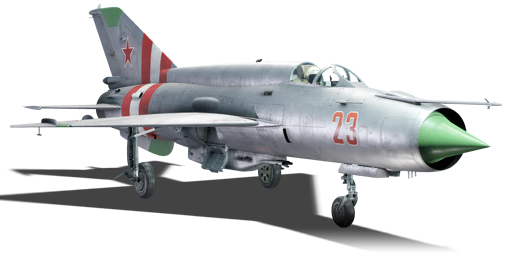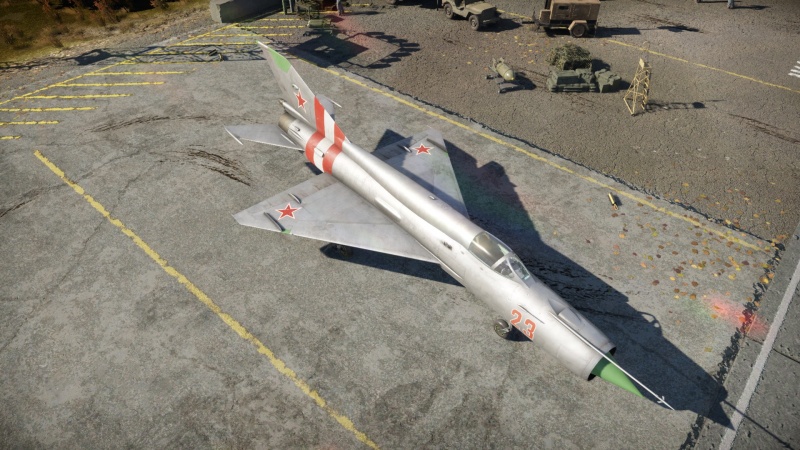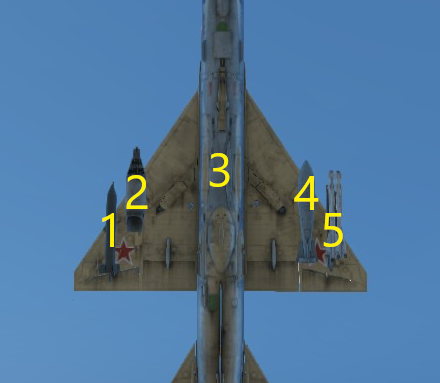MiG-21S (R-13-300)
| This page is about the Soviet jet fighter MiG-21S (R-13-300). For other versions, see MiG-21 (Family). |
Contents
Description
The MiG-21S (R-13-300) (NATO Code: Fishbed-J) is a premium rank VI Soviet jet fighter with a battle rating of 9.0 (AB), 9.7 (RB), and 10.0 (SB). It was introduced in Update "Winged Lions".
General info
Flight performance
Like all Mig-21s, the Mig-21S is a very fast interceptor. With a powerful engine (the same used by the Mig-21SMT), the Mig-21S has very good acceleration and top speed compared to other supersonic fighters like the Mig-19, the F-100 Super Sabre and the F-105D. Being a delta wing fighter, it's capable of extreme manoeuvres, but it losses speed very quickly and in a few turns it would be stuck at less than 600KM/h.
| Characteristics | Max Speed (km/h at 13,000 m) |
Max altitude (metres) |
Turn time (seconds) |
Rate of climb (metres/second) |
Take-off run (metres) | |||
|---|---|---|---|---|---|---|---|---|
| AB | RB | AB | RB | AB | RB | |||
| Stock | 2,190 | 2,172 | 16000 | 36.2 | 37.0 | 134.7 | 126.5 | 750 |
| Upgraded | 2,313 | 2,240 | 34.2 | 35.0 | 187.6 | 160.0 | ||
Details
| Features | |||||
|---|---|---|---|---|---|
| Combat flaps | Take-off flaps | Landing flaps | Air brakes | Arrestor gear | Drogue chute |
| X | ✓ | ✓ | ✓ | X | ✓ |
| Limits | ||||||
|---|---|---|---|---|---|---|
| Wings (km/h) | Gear (km/h) | Flaps (km/h) | Max Static G | |||
| Combat | Take-off | Landing | + | - | ||
| 1365 | 700 | N/A | 500 | 450 | ~12 | ~6 |
| Optimal velocities (km/h) | |||
|---|---|---|---|
| Ailerons | Rudder | Elevators | Radiator |
| < 650 | < 600 | < 950 | N/A |
Engine performance
| Engine | Aircraft mass | ||||||
|---|---|---|---|---|---|---|---|
| Engine name | Number | Basic mass | Wing loading (full fuel) | ||||
| Tumansky R-13-300 | 1 | 5,962 kg | 359 kg/m2 | ||||
| Engine characteristics | Mass with fuel (no weapons load) | Max Takeoff Weight | |||||
| Weight (each) | Type | 11m fuel | 20m fuel | 30m fuel | 38m fuel | ||
| 1,135 kg | Afterburning axial-flow turbojet | 6,651 kg | 7,169 kg | 7,773 kg | 8,258 kg | 9,900 kg | |
| Maximum engine thrust @ 0 m (RB/SB) | Thrust to weight ratio @ 0 m (WEP) | ||||||
| Condition | 100% | WEP | 11m fuel | 20m fuel | 30m fuel | 38m fuel | MTOW |
| Stationary | 3,825 kgf | 6,483 kgf | 0.97 | 0.90 | 0.83 | 0.79 | 0.65 |
| Optimal | 3,825 kgf (0 km/h) |
6,977 kgf (1,200 km/h) |
1.05 | 0.97 | 0.90 | 0.84 | 0.70 |
Survivability and armour
The MiG-21S (R-13-300) can take hits from calibres lower than 30 mm guns in minor parts, but if the engine is damaged it will surely fall. A missile hit will knock out the fighter instantly or cause it to crash.
Modifications and economy
Armaments
| Ballistic Computer | |||
|---|---|---|---|
| CCIP (Guns) | CCIP (Rockets) | CCIP (Bombs) | CCRP (Bombs) |
| |
|
|
|
Offensive armament
The MiG-21S (R-13-300) is armed with:
- 1 x 23 mm GSh-23L cannon, belly-mounted (200 rpg)
The GSh-23L is a very powerful weapon, that requires practice to be used properly. It has a low muzzle velocity and a small ammo pool compared to other planes of it's BR. But it compensates this with a very good damage output, being capable of destroying almost any aircraft with a small burst.
Suspended armament
The MiG-21S (R-13-300) can be outfitted with the following ordnance presets:
- Without load
- 2 x R-3S missiles
- 4 x R-3S missiles
- 4 x R-3R missiles
- 64 x S-5K rockets
- 64 x S-5K rockets
- 4 x S-24 rockets
- 4 x 250 kg OFAB-250sv bombs (1,000 kg total)
- 2 x 500 kg FAB-500M-54 bombs (1,000 kg total)
- 2 x ZB-500 incendiary bombs
The Mig-21S can equip several options for both air to air kills and ground support.
For Air to Air combat the R-3R and R-3R missiles are the only options. These missiles share the same properties but the R-3S is a caged IR missile, that means that it needs to point directly to the back of an enemy aircraft in order to get a lock. The R-3R in the other hand is a radar guided missile. Unlike the R-3S, it has a small area in which the aircraft can change direction, making it possible to aim the missile for the position in which the enemy is heading. The R-3R is overall a better missile but it's hard to use close to the ground due to the lackluster radar in the Mig-21, and the R-3S is excellent in picking slow moving enemies at any altitude and moment.
For ground ordinance the Mig-21S has ballistic computers for both rockets and it's cannon. So in ground RB it's possible to use it as a multirole fighter, with 2 rocket pods and 2 missiles for air to air combat, providing cover to the team.
Custom loadout options
| 1 | 2 | 3 | 4 | ||
|---|---|---|---|---|---|
| 250 kg OFAB-250sv bombs | 1 | 1 | 1 | 1 | |
| 500 kg FAB-500M-54 bombs | 1 | 1 | |||
| ZB-500 incendiary bombs | 1 | 1 | |||
| S-5K rockets | 16 | 16, 32 | 16, 32 | 16 | |
| S-24 rockets | 1 | 1 | 1 | 1 | |
| R-3R missiles | 1 | 1 | 1 | 1 | |
| R-3S missiles | 1 | 1 | 1 | 1 | |
| Maximum permissible weight imbalance: 570 kg | |||||
Usage in battles
The MiG-21S (R-13-300) is an excellent fighter when used in high altitudes or support roles, when it's engine makes it a very awkward opponent.
Use in Arcade Battles:
In AB, the Mig-21S will constantly see a multitude of enemies, but the most dangerous ones would be the A-10, the F-5C and other Mig-21s. In this battles staying at high altitudes and managing the afterburner use is very important, since missiles like the AIM-9L and R-60M and early radar missiles would be a dangerous threat to the Mig-21S due to it's lack of countermeasures. Thus, staying fast and high, and using it's radar missiles from good positions would make you survive longer and be a more useful teammate.
Use in Realistic Battles:
In RB the Mig-21S should also be used in a support role and at high altitudes but it can also be used as a frontline fighter, however, with more risk. When flying at altitudes above 5000M the Mig-21S easily reaches Mach 1.3, and it's radar is free of ground cluster. At this altitudes, common enemies are the F-104 Starfighter, other Mig-21s, Harriers and the F-8E Crusader, being this one the most dangerous thanks to the AIM-9C radar guided missile and countermeasures. At higher altitudes the missiles can fly longer and faster, while aircrafts became more sluggish due to the thinner atmosphere. Something very good since the R-3Rs are very early missiles and can't pull very hard. In a support role, attacking slow aircrafts, specially those focused in fights or bomb runs, is a good way to help your team to stay relevant. It's good speed also makes the Mig-21S a very good hunter, attacking damaged aircrafts that are falling back to their airfields.
Use in Simulator Battles:
In SB, the Mig-21S is a more tricky fighter. Because it has a radar with IFF (Identification friend or foe) It can be used in high altitudes to intercept enemy bombers and other fighters. But it's lack of countermeasures would cement it's future in that role. Fortunately it has an RWR. Something very useful to know when another plane has a radar lock on you. Aside from that, pilots should be extremely careful, because even with an IFF system, the Mig-21S can lock onto allied aircrafts and cause friendly fire incidents. For ground loadouts, the Mig-21S has a very bad frontal cockpit visibility, making CAS duties really hard even with the ballistics computer for bombs and rockets.
Pros and cons
Pros:
- Fast aircraft, possesses a powerful engine that will get you to the battle much quicker than most
- Multiple loadouts allow decent CAS/AA options for Ground RB
- Radar missiles can surprise opponents not expecting to be engaged at such a distance
- Tight turn rate
Cons:
- Air-to-air missiles are underwhelming and are mostly effective only against inattentive pilots
- Bleeds excessive amounts of energy during turns
- Cannon requires careful use due to the limited amount of rounds
- Energy retention isn't the greatest
- Fuel-hungry engine, 20m of fuel will quickly disappear if not paying attention
History
The Mig-21S was a variant of the Mig-21 family for more multipurpose design. It fitted more fuel capacity, a cannon pod, four hard points and an RP-22 radar. It was delivered exclusively to the Soviet Air Force. This variant included a more capable powerplant, the R11F2S-300 engine, which gave it significantly more thrust.
The Mig-21S radar, was a production version of the Sapfir-21 and included several more features for increased survivability and multirole capabilities. It included an ASP-PF-21 computing gunsight with ballistics computer. Included an AP-155 autopiloting system, with an auto recovery system for use in emergencies. The airframe was similar but not the same as that of the Mig-21PFM, since it used the same saddle tank as the Mig-21R. It was capable of carrying the GP-9 cannon pod for the GSh-23L 23mm gun. It's four hard points made it capable of carrying drop tanks, for increased fuel capacity at long flights.
In it's arsenal, it included the R-3R radar guided missile (K-13R), a semi active radar homing missile based in the R-3S (K-13) missile, which was not present in the Mig-21PFM even though it had the same radar as the Mig-21S. This variant of the Mig-21 was produced for 1965 to 1968 and saw no use outside of the Soviet Union.
Media
- Skins
- Videos
See also
Links to the articles on the War Thunder Wiki that you think will be useful for the reader, for example:
- reference to the series of the aircraft;
- links to approximate analogues of other nations and research trees.
External links
| Mikoyan-Gurevich Design Bureau (Микоя́н и Гуре́вич Опытное конструкторское бюро) | |
|---|---|
| Fighters | MiG-3-15 · MiG-3-15 (BK) · MiG-3-34 |
| I-225 | |
| Jet fighters | MiG-9 · MiG-9 (l) |
| MiG-15 · MiG-15bis · MiG-15bis ISh | |
| MiG-17 | |
| MiG-19PT | |
| MiG-21F-13 · MiG-21PFM · MiG-21S (R-13-300) · MiG-21SMT · MiG-21bis | |
| MiG-23M · MiG-23ML · MiG-23MLD | |
| MiG-27M · MiG-27K | |
| MiG-29 · MiG-29SMT | |
| Export/Licensed | ␗MiG-9 · ␗MiG-9 (l) |
| ◊MiG-15bis · ◔MiG-15bis · J-2* | |
| MiG-17AS · ◔MiG-17PF · J-4* · Shenyang F-5* | |
| ◊MiG-19S · J-6A* | |
| ◄MiG-21 SPS-K · ◊MiG-21MF · ◔MiG-21MF · ▄MiG-21bis · ◔MiG-21bis-SAU · ◊MiG-21bis-SAU · ◊MiG-21 "Lazur-M" · ▄MiG-21 Bison · J-7II** | |
| ◊MiG-23BN · ◊MiG-23MF · ◔MiG-23MF · ◊MiG-23MLA | |
| ◔MiG-29 · ◊MiG-29 · ◄MiG-29G | |
| *Licensed and domesticated with Chinese designations. | |
| **Unlicensed, reverse-engineered and domesticated with Chinese designations. | |
| See Also | Shenyang · Chengdu |
| USSR jet aircraft | |
|---|---|
| Bereznyak-Isayev | BI |
| Yakovlev | Yak-15 · Yak-15P · Yak-17 · Yak-23 · Yak-28B · Yak-30D · Yak-38 · Yak-38M · Yak-141 |
| Mikoyan-Gurevich | MiG-9 · MiG-9 (l) · MiG-15 · MiG-15bis · MiG-15bis ISh · MiG-17 · MiG-17AS · MiG-19PT |
| MiG-21F-13 · MiG-21PFM · MiG-21S (R-13-300) · MiG-21SMT · MiG-21bis | |
| MiG-23M · MiG-23ML · MiG-23MLD · MiG-27M · MiG-27K | |
| MiG-29 · MiG-29SMT | |
| Lavochkin | La-174 · La-15 · La-200 |
| Sukhoi | Su-9 · Su-11 |
| Su-7B · Su-7BKL · Su-7BMK · Su-17M2 · Su-17M4 · Su-22M3 | |
| Su-24M | |
| Su-25 · Su-25BM · Su-25K · Su-25T · Su-25SM3 · Su-39 | |
| Su-27 · Su-27SM | |
| Su-34 | |
| Ilyushin | IL-28 · IL-28Sh |
| Tupolev | Tu-14T |
| USSR premium aircraft | |
|---|---|
| Fighters | Krasnolutsky's I-15bis · I-16 type 28 · Zhukovsky's I-153-M62 · I-153P · I-180S · I-301 · ITP (M-1) |
| LaGG-3-4 · LaGG-3-23 · LaGG-3-34 · Dolgushin's La-7 · La-11 | |
| Eremin's Yak-3(e) · Yak-3 (VK-107) · Yak-3T · Golovachev's Yak-9M | |
| ▂P-39K-1 · ▂Pokryshkin's P-39N-0 · ▂P-39Q-15 · ▂P-40E-1 · ▂P-47D-27 · ▂P-63A-5 · ▂P-63A-10 · ▂P-63C-5 | |
| ▂Hurricane Mk IIB · ▂Spitfire Mk IXc · ▂Fw 190 D-9 | |
| Twin-engine fighters | I-29 |
| Jet fighters | Su-11 · MiG-15bis ISh · MiG-17AS · MiG-21S (R-13-300) · MiG-23ML |
| Strike aircraft | IL-2M "Avenger" · IL-2 M-82 · IL-8 (1944) · Su-6 · Tandem MAI · TIS MA · Su-8 · Tu-1 |
| Yak-38 · Su-7BMK · Su-25K · Su-39 | |
| Bombers | Po-2M · Be-6 · MBR-2-M-34 · Pe-2-205 · TB-3M-17-32 |
| ▂PBY-5A Catalina · ▂Hampden TB Mk I · ▂A-20G-30 · ▂B-25J-30 | |






